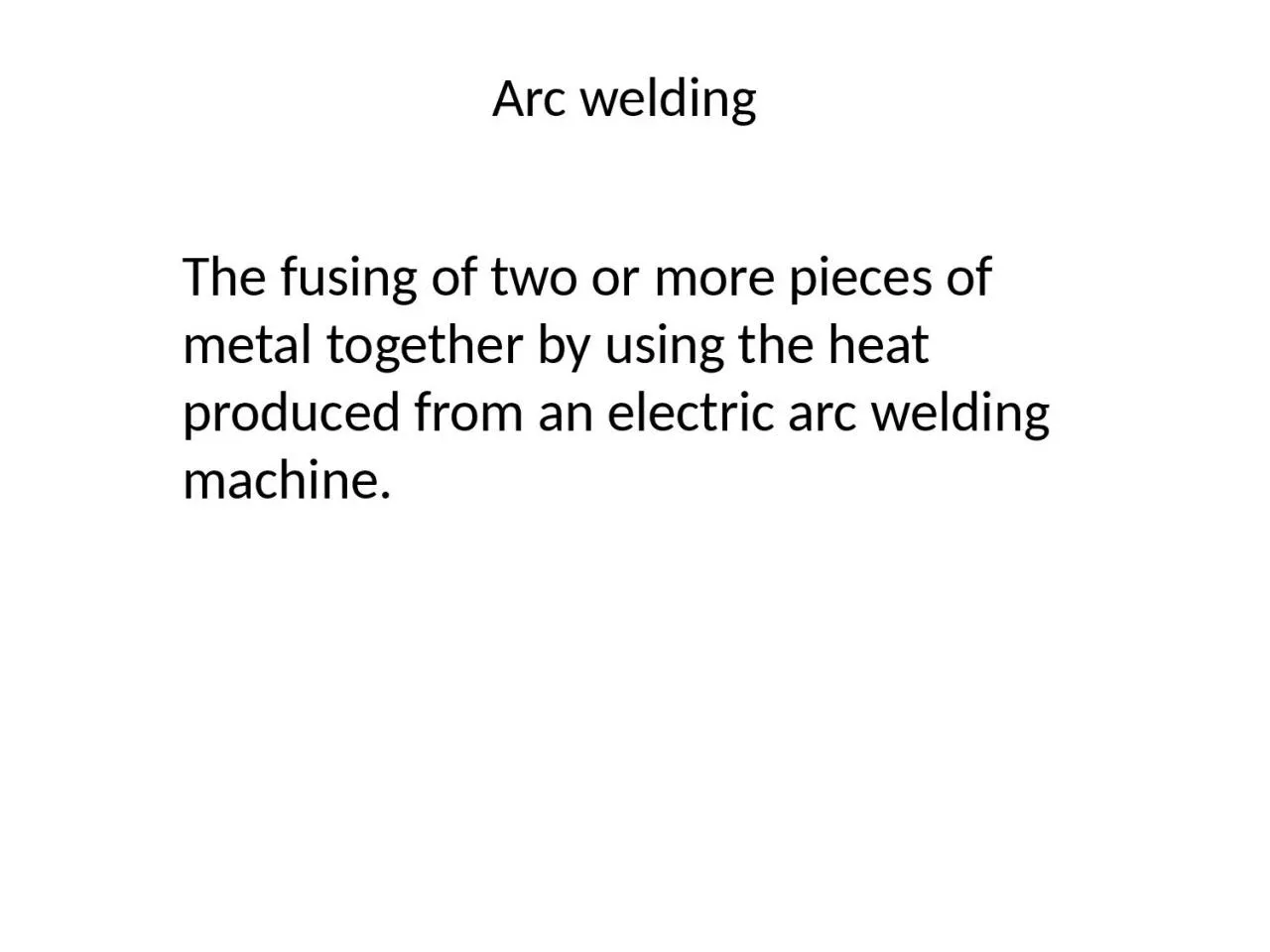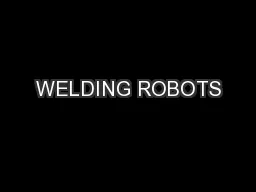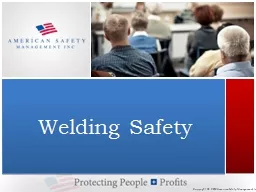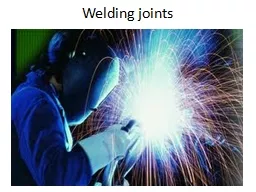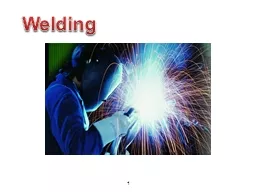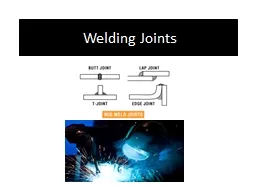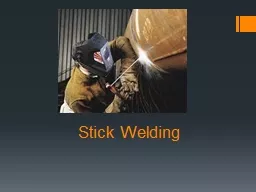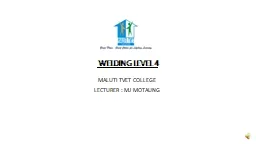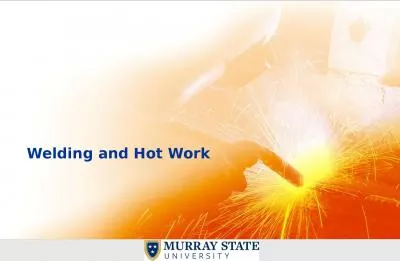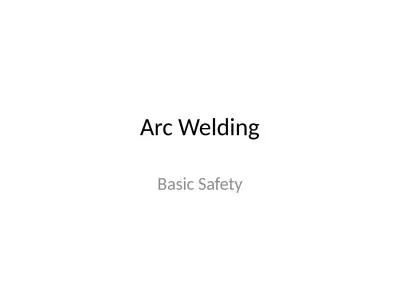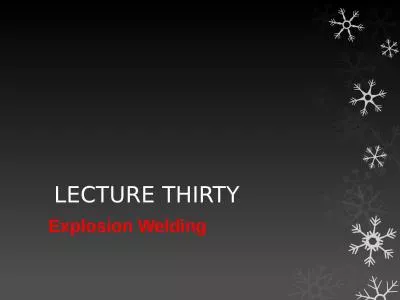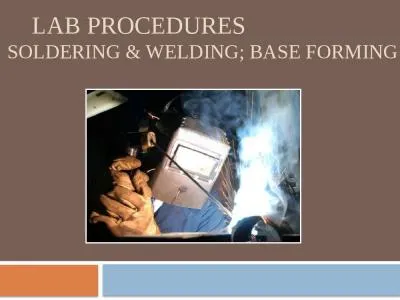PPT-Arc welding The fusing of two or more pieces of metal together by using the heat produced
Author : jordyn | Published Date : 2023-05-22
How an arc is formed The arc is like a flame of intense heat that is generated as the electrical current passes through a highly resistant air gap Arc welding process
Presentation Embed Code
Download Presentation
Download Presentation The PPT/PDF document "Arc welding The fusing of two or more pi..." is the property of its rightful owner. Permission is granted to download and print the materials on this website for personal, non-commercial use only, and to display it on your personal computer provided you do not modify the materials and that you retain all copyright notices contained in the materials. By downloading content from our website, you accept the terms of this agreement.
Arc welding The fusing of two or more pieces of metal together by using the heat produced: Transcript
How an arc is formed The arc is like a flame of intense heat that is generated as the electrical current passes through a highly resistant air gap Arc welding process Tungsten Inert Gas welding Welding torch. INTRODUCTION. ELECTRIC ARC WELDING. The welding in which the electric arc is produced to give heat for the purpose of joining two . surfaces is . called electric arc welding. Principle. Power supply is given to electrode and the work. A suitable gap is kept between the work . INTRODUCTION. . Robot Welding . is a process of joining different materials. . The . large bulk of materials that are welded are metals and their alloys although welding is also applied to the joining of other materials such as thermoplastics. http://www.gooddirections.co.uk/mach/Mach%20Precision%20Engineering%20Images/Welding%20Metal%20Fabrication%20Home.jpg. Welding 1 . Ibook. Chapter 1 Introduction to gas welding. 1.1 Welding Processes. Definitions. Weld. A localized fusion of metals produced by heating to suitable temperatures. . Pressure and/or filler metal may or may not be used. . The filler material has a melting point . approximately . T-joint. T-joint welded using arc welding. T-joint welded using . tig. T-joint welded using . mig. Lap joint. Lap joint welded using . tig. Lap joint welded using arc welding. Lap joint welded using . Joining and Assembly. Joining . - . welding. , . brazing. , . soldering. , and adhesive bonding. These processes form a permanent joint between parts. Assembly - mechanical methods (usually) of fastening parts together. T-Joint. T-Joint made by Arc welding. T-Joint made by MIG welding. T-Joint oxygen acetylene. Butt Joint. Butt Weld from Arc Welding. Butt welding using. Oxygen . A. cetylene . Butt Welding using . MIG Welding. Know at least 25% of the shop safety terms. Know at least 50% of the shop safety terms. Know at least 75% of the shop safety terms. Know all 100% of the shop safety terms. Review Questions - #1- #10. Chapter 3 Shielded Metal Arc Equipment, Setup, and Operation OBJECTIVES After completing this chapter, the student should be able to describe the process of shielded metal arc welding (SMAW). list and define the three units used to measure a welding current. MALUTI TVET COLLEGE. LECTURER : MJ MOTAUNG. . . TOPIC :5 UNIT :1. . . GAS TUNGSTEN ARC WELDING. LO :. Explain the terminologies associated with gas tungsten arc welding procedure.. Hot work . is any work process that produces flames or sparks that present a fire ignition hazard to the surrounding environment and personnel.. Gas torch welding and cutting. . uses a flame to join or cut metal.. Warnings. Welding can be safe when proper measures are taken to protect yourself and others from potential hazards.. . Understand and follow all warning labels found on equipment and with all consumables.. Explosion welding (EXW) is a solid-state welding process in which rapid coalescence of two metallic surfaces is caused by the energy of a detonated explosive. .. It is commonly used to bond two . dissimilar metals. . CONTENTS:. . Introduction. Definitions. Soldering. - Classification of solders. - Classification of fluxes. - Heat source in soldering. - Techniques of soldering.
Download Document
Here is the link to download the presentation.
"Arc welding The fusing of two or more pieces of metal together by using the heat produced"The content belongs to its owner. You may download and print it for personal use, without modification, and keep all copyright notices. By downloading, you agree to these terms.
Related Documents

